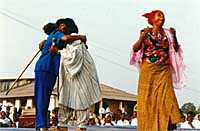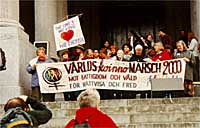The New Caledonian women's march centred around the circulation of women's words against poverty and violence against women. The "circulating words," which were both symbolic and concrete, went around the country for one month and a half. In each community, women gave the authorities a piece of manu as a sign of their will to fight.
Ghanaian women launched their March on March 8, 2000 with songs and theatre, and Australian women ended theirs with a week of shows in various cities. On Réunion Island, women spoke on October 17, 2000, Saint-Denis, also drawing on other forms, including song, poetry, music and theatre.
On the same date in Montevideo, Uruguay, women celebrated the day with music. They also read out statistics on violence against women in their country.
In Kenya, one of the groups participating in the March staged a play denouncing men's brutality towards their partners. Theatre was also used as a resource in the Philippines and in Nepal to raise the issue of sex trafficking of women and young girls, and in the Netherlands to speak about poverty among women .
Women resorted to many different mediums to write what they had to say: pieces of cardboard used to cover roofs in slums in Haiti, women's saris and men's dotis in India. In Brussels, on October 14, 2000, the European women displayed a knitted scarf 5.5 kilometres long into which they had woven the many colours of solidarity.
At times the means of expression was silence, which was in fact a clamour. On March 8, 2000, the women of the Congo (Kinshasa) locked themselves away at home to grieve over their loved ones killed in the war.








